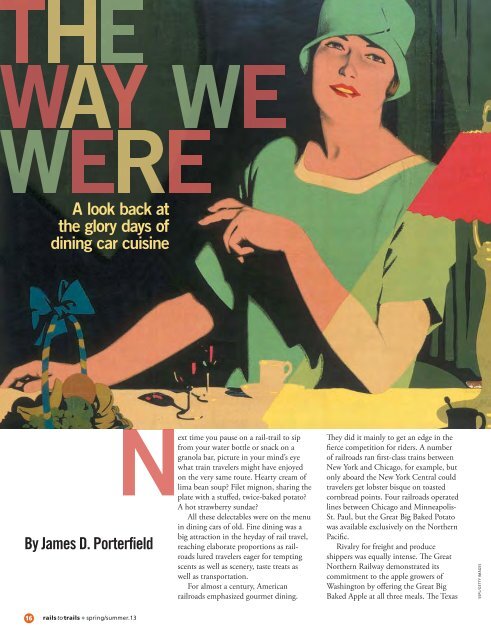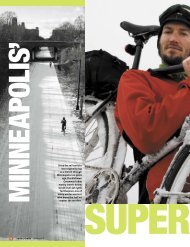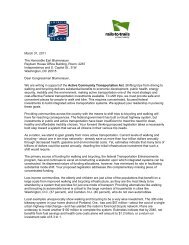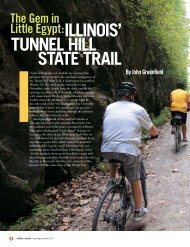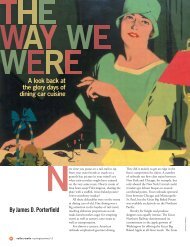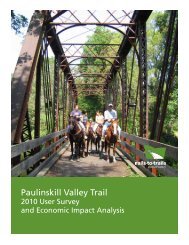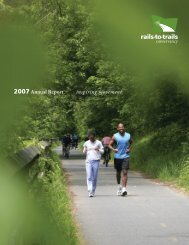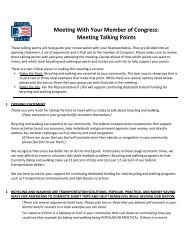The Way We Were (PDF 826KB) - Rails-to-Trails Conservancy
The Way We Were (PDF 826KB) - Rails-to-Trails Conservancy
The Way We Were (PDF 826KB) - Rails-to-Trails Conservancy
You also want an ePaper? Increase the reach of your titles
YUMPU automatically turns print PDFs into web optimized ePapers that Google loves.
A look back at<br />
the glory days of<br />
dining car cuisine<br />
By James D. Porterfield<br />
Next time you pause on a rail-trail <strong>to</strong> sip<br />
from your water bottle or snack on a<br />
granola bar, picture in your mind’s eye<br />
what train travelers might have enjoyed<br />
on the very same route. Hearty cream of<br />
lima bean soup? Filet mignon, sharing the<br />
plate with a stuffed, twice-baked pota<strong>to</strong>?<br />
A hot strawberry sundae?<br />
All these delectables were on the menu<br />
in dining cars of old. Fine dining was a<br />
big attraction in the heyday of rail travel,<br />
reaching elaborate proportions as railroads<br />
lured travelers eager for tempting<br />
scents as well as scenery, taste treats as<br />
well as transportation.<br />
For almost a century, American<br />
railroads emphasized gourmet dining.<br />
<strong>The</strong>y did it mainly <strong>to</strong> get an edge in the<br />
fierce competition for riders. A number<br />
of railroads ran first-class trains between<br />
New York and Chicago, for example, but<br />
only aboard the New York Central could<br />
travelers get lobster bisque on <strong>to</strong>asted<br />
cornbread points. Four railroads operated<br />
lines between Chicago and Minneapolis-<br />
St. Paul, but the Great Big Baked Pota<strong>to</strong><br />
was available exclusively on the Northern<br />
Pacific.<br />
Rivalry for freight and produce<br />
shippers was equally intense. <strong>The</strong> Great<br />
Northern Railway demonstrated its<br />
commitment <strong>to</strong> the apple growers of<br />
Washing<strong>to</strong>n by offering the Great Big<br />
Baked Apple at all three meals. <strong>The</strong> Texas<br />
SSPL/GETTY IMAGES<br />
16<br />
rails<strong>to</strong>trails ◆ spring/summer.13
and Pacific Railway showed allegiance<br />
<strong>to</strong> melon growers in Arkansas by offering<br />
cantaloupe pie. Some railroads went<br />
so far as <strong>to</strong> establish test kitchens <strong>to</strong><br />
develop recipes using ingredients their<br />
lines carried, from Idaho’s pota<strong>to</strong>es on the<br />
Union Pacific <strong>to</strong> California’s rice on the<br />
Southern Pacific.<br />
UNIVERSALIMAGESGROUP/GETTY IMAGES<br />
First Course<br />
It all started in 1867.<br />
Just three years after<br />
George Pullman introduced<br />
the modern<br />
American sleeping car,<br />
he modified one of the<br />
cars, adding a small<br />
kitchen and an apparatus<br />
between facing<br />
seats <strong>to</strong> allow a table<br />
<strong>to</strong> be anchored <strong>to</strong> the<br />
car’s wall. He called<br />
the design a “hotel<br />
car” and christened<br />
this first model “President.” A year later,<br />
he introduced the first full dining car,<br />
naming it “Delmonico,” in honor of the<br />
famous New York restaurant.<br />
Pullman’s dining cars evolved over<br />
the years <strong>to</strong> comprise a 7-by-18-foot<br />
kitchen where four cooks prepared and<br />
plated food; a 7-by-8-foot pantry where<br />
six waiters prepared salads, beverages and<br />
desserts; and an 11-by-40-foot dining<br />
room that seated 36 passengers. Seating<br />
capacity later increased <strong>to</strong> 42. A steward<br />
oversaw the car, which served three meals<br />
a day <strong>to</strong> as many as 300 passengers.<br />
Popular as the Pullman dining cars<br />
were, with an 11-member crew they rarely<br />
were profitable. (<strong>The</strong>re was<br />
one exception: <strong>The</strong> New York,<br />
New Haven and Hartford<br />
Railroad, running first-class<br />
trains between Bos<strong>to</strong>n and<br />
New York, derived 72 percent<br />
of its dining car revenue from<br />
alcohol, a highly profitable<br />
menu item.) Thus, while the<br />
Pullman Company routinely<br />
leased sleeping cars <strong>to</strong> the railroads,<br />
at one time becoming<br />
America’s largest hotel chain,<br />
it got out of the dining car business within<br />
a few years.<br />
What followed was a remarkable<br />
burst of creativity, as competing railroads<br />
sought <strong>to</strong> distinguish their own dining<br />
cars and menus. Between the 1920s and<br />
1950s, railroad dining cars were among<br />
the best restaurants in the country. <strong>The</strong><br />
MPI/GETTY IMAGES<br />
railroads often entered<br />
their most skilled chefs<br />
in culinary competitions<br />
<strong>to</strong> vie against<br />
chefs from major<br />
hotels, resorts and<br />
country clubs. It was<br />
not uncommon for<br />
the railroads <strong>to</strong> win<br />
some, if not all, of<br />
the ribbons. <strong>The</strong> railroads<br />
publicized these<br />
culinary kudos widely<br />
along their routes.<br />
First Class<br />
<strong>The</strong> Torrey C. Brown Rail Trail and<br />
Heritage Rail Trail County Park between<br />
Cockeysville, Md., and York, Pa., occupies<br />
the bucolic 41-mile route of one of<br />
America’s oldest railroads, the Northern<br />
Central Railway. Chartered in 1828 <strong>to</strong><br />
connect Baltimore with Lake Ontario,<br />
the Northern Central came under the<br />
control of the Pennsylvania Railroad<br />
and saw heavy passenger traffic featuring<br />
important first-class trains—including<br />
the Liberty Limited and the Red Arrow—<br />
between Washing<strong>to</strong>n, D.C., or Baltimore<br />
and Harrisburg, Pa. In the first half of<br />
the 20th century, as many as 23 first-class<br />
passenger trains raced along the route<br />
each day.<br />
To feed the many people on board,<br />
chefs in the dining cars had <strong>to</strong> work<br />
quickly. <strong>The</strong> key <strong>to</strong> success was <strong>to</strong> use<br />
everyday ingredients and a minimum<br />
of preparation steps. Passengers might<br />
rails<strong>to</strong>trails ◆ spring/summer.13 17
Dinner Is<br />
Served<br />
<strong>The</strong>se simple yet striking recipes<br />
are your ticket <strong>to</strong> fine dining,<br />
railroad style.<br />
Pennsylvania Railroad<br />
Deviled Roast Beef<br />
With Mustard Sauce<br />
Makes a single serving<br />
Roast Beef<br />
1/4-inch slice cooked roast beef<br />
salt and pepper <strong>to</strong> taste<br />
1/2 tbsp. butter<br />
1/2 tbsp. English mustard<br />
(Colman’s is the most common brand)<br />
soft white bread crumbs <strong>to</strong> cover<br />
Season one side of roast beef with salt and<br />
pepper. Sprinkle lightly with melted butter,<br />
then spread with English mustard. Sprinkle<br />
lightly with bread crumbs. Broil 5 inches<br />
from heat source until warmed through and<br />
lightly browned, about 4 minutes. Serve in a<br />
pool of mustard sauce on a dinner plate, and<br />
garnish with a sprig of fresh parsley.<br />
sit down <strong>to</strong> enjoy a<br />
chilled melon mint<br />
cocktail: five ingredients<br />
prepared in<br />
quantity in 15 minutes.<br />
Menus show the<br />
next course could be<br />
a thick, rich chicken<br />
soup Roquefort:<br />
seven ingredients,<br />
45 minutes. Like all<br />
railroad soups, it is<br />
a cream, not clear,<br />
soup, so it is less<br />
likely <strong>to</strong> slosh out of the bowl.<br />
Like many other lines, the<br />
Pennsylvania Railroad developed and<br />
served its own signature salad dressing.<br />
<strong>The</strong> dinner entrée might be deviled roast<br />
beef with mustard sauce (see sidebar for<br />
recipe), served with a seasoned baked<br />
pota<strong>to</strong> Pennsylvania and corn and green<br />
pepper sauté. To complete the meal—<br />
Pennepicure Pie, a rich raisin custard pie<br />
<strong>to</strong>pped with meringue.<br />
his dining car menu<br />
offerings and traveled<br />
extensively <strong>to</strong> oversee<br />
the company’s cooks.<br />
It<br />
was, incidentally, a<br />
Milwaukee Road dining<br />
car superintendent<br />
who invented the ring<br />
around the inner rim of<br />
his railroad’s coffee cups<br />
<strong>to</strong><br />
keep hot beverages<br />
from spilling over.<br />
Ot her r ailroads<br />
hired elite chefs as well.<br />
Notable among them were Paul Reiss of<br />
the Southern Pacific and Fred Harvey of<br />
the Atchison, Topeka & Santa Fe.<br />
“House” Specialties<br />
As well as being the country’s longest<br />
rail-trail under a single administration,<br />
Missouri’s 238-mile Katy Trail is also a<br />
standout in the world of railroad dining.<br />
Katy Kornettes, special cornbread nuggets,<br />
could be had only on such Missouri-<br />
ERNEST YEAGLEY<br />
Mustard Sauce<br />
1 small onion, chopped<br />
1/8 tsp. fresh ground black pepper<br />
1 tbsp. white vinegar<br />
1/3 cup brown gravy<br />
1 tbsp. English mustard<br />
1/4 tsp. seasoning salt<br />
1/2 tbsp. butter<br />
1/4 tsp. parsley, chopped<br />
Place onion, black pepper and vinegar in<br />
saucepan. Cook over medium heat until<br />
vinegar evaporates, about 5 minutes. Add<br />
gravy, mustard and seasoning salt. Simmer<br />
15 minutes. Strain and add butter and<br />
chopped parsley. Return <strong>to</strong> saucepan and<br />
heat until butter is melted. <strong>The</strong> key <strong>to</strong> this<br />
sauce is that it be very well seasoned.<br />
NOTE: This recipe can be prepared using<br />
slices of premium-quality roast beef from<br />
the deli. In fact, as with many railroad<br />
recipes, all the ingredients can be purchased<br />
at your local grocery.<br />
Chef’s Cuisine<br />
Idaho’s scenic 15-mile Route of the<br />
Hiawatha rail-trail follows a 15-mile<br />
section of the Chicago, Milwaukee,<br />
St. Paul and Pacific Railroad corridor,<br />
another popular dining car route. Known<br />
as <strong>The</strong> Milwaukee Road, it was the last of<br />
the major Chicago <strong>to</strong> Seattle transcontinental<br />
railroads.<br />
In 1928, <strong>to</strong> set its menus apart from<br />
those of its better-known rivals, the Great<br />
Northern and the Northern Pacific, <strong>The</strong><br />
Milwaukee Road hired chef and restaurateur<br />
George Rec<strong>to</strong>r <strong>to</strong> provide “the<br />
finishing <strong>to</strong>uch <strong>to</strong> fine service.” Rec<strong>to</strong>r<br />
was world famous, <strong>to</strong>uring internationally<br />
<strong>to</strong> demonstrate his cooking prowess,<br />
penning numerous cookbooks and writing<br />
a weekly column for <strong>The</strong> Saturday<br />
Evening Post. For <strong>The</strong> Milwaukee Road,<br />
he became “the master hand <strong>to</strong> direct<br />
cuisine,” creating such mouthwatering<br />
menu items as Crabmeat Olympia<br />
Hiawatha, Scalloped Brussels Sprouts and<br />
Scrambled Codfish Rec<strong>to</strong>r. He instructed<br />
others in the correct preparation of<br />
On the Menu: Railroads paid close attention<br />
<strong>to</strong> menu planning for children, the next<br />
generation of passengers. Children’s menus<br />
were entertaining and informative; young<br />
diners also received coloring books and<br />
crayons, playing cards, or perhaps milk and a<br />
cookie. This illustration comes from a Great<br />
Northern Railway booklet about train rides.<br />
CRAIG AND MARTY NEROS<br />
18<br />
rails<strong>to</strong>trails ◆ spring/summer.13
Ticket <strong>to</strong><br />
Dining Car His<strong>to</strong>ry<br />
Graham Gems: Many Class I railroads used<br />
cus<strong>to</strong>mized dining car china, often unique<br />
<strong>to</strong> specific trains, such as the Union Pacific’s<br />
Winged Streamliner pattern, introduced in<br />
1936. Railroads frequently offered specialty<br />
items available only in their dining cars. <strong>The</strong>se<br />
Graham Gems, sweet milk muffins, were<br />
served exclusively on the New York, New<br />
Haven and Hartford Railroad. <strong>The</strong>n there were<br />
the Pennsylvania Railroad’s Ginger Muffins,<br />
<strong>The</strong> Milwaukee Road’s Richmond Corn Cakes,<br />
and the Great Northern Railway’s Pota<strong>to</strong> Rolls.<br />
Kansas-Texas Railroad trains as the Katy<br />
Flier and the Bluebonnet. Travelers on<br />
these trains could look forward <strong>to</strong> the<br />
basket of warm Kornettes on their table<br />
in the dining car (see sidebar page 20).<br />
<strong>The</strong> Illinois Central Railroad, which<br />
connected Chicago with New Orleans,<br />
specialized in Cajun cuisine. Passengers<br />
often boarded the northbound Panama<br />
Limited or City of New Orleans in<br />
Champaign-Urbana, Ill., just <strong>to</strong> enjoy<br />
a Cajun meal going in<strong>to</strong> Chicago, then<br />
<strong>to</strong>ok a local train back home.<br />
<strong>The</strong> Baltimore and Ohio Railroad<br />
delighted travelers with saltwater seafood<br />
served on trains traveling west <strong>to</strong> Chicago<br />
or St. Louis, and freshwater seafood on<br />
trains traveling east <strong>to</strong> Baltimore and<br />
Washing<strong>to</strong>n. <strong>The</strong> New York, New Haven<br />
and Hartford Railroad perfected salads as<br />
an entrée, at one time listing nearly 70 in<br />
its food service manual.<br />
In addition, railroads—especially<br />
<strong>We</strong>stern lines such as <strong>The</strong> Milwaukee<br />
Road—routinely bought up prizewinning<br />
lives<strong>to</strong>ck at state agricultural<br />
fairs. Those champions were employed for<br />
breeding purposes on the railroads’ own<br />
cattle farms, which supplied the dining<br />
cars.<br />
Hungry for more information about<br />
dining cars and railroad cuisine?<br />
You’ll enjoy these books:<br />
C&O Dining Car Recipes, a reprint of the<br />
1947 Chesapeake & Ohio food service<br />
manual from the C&O His<strong>to</strong>rical Society,<br />
chessieshop.com or 800.453.2647.<br />
Dining by Rail: <strong>The</strong> His<strong>to</strong>ry and Recipes of<br />
America’s Golden Age of Railroad Cuisine,<br />
by James D. Porterfield, a his<strong>to</strong>ry of eating<br />
on the train featuring 330 recipes from 48<br />
railroads of the “Golden Age” of American<br />
passenger railroading. St. Martin’s Press.<br />
Dining Car <strong>to</strong> the Pacific: <strong>The</strong> “Famously<br />
Good” Food of <strong>The</strong> Northern Pacific<br />
Railway, by William A. McKenzie, an<br />
account of the evolution of one railroad’s<br />
dining car operations, including recipes<br />
for 150 of its most appealing dishes.<br />
University of Minnesota Press.<br />
Dining Cars and Depots: Train Food in<br />
America, compiled and published by<br />
Patricia B. Mitchell, offering his<strong>to</strong>rical and<br />
personal anecdotes as well as 21 recipes.<br />
Available from Foxfire Museum gift shop:<br />
foxfire.org/diningcarsanddepots.aspx.<br />
Dining on the B & O: Recipes and<br />
Sidelights From a Bygone Age, by Thomas<br />
J. Greco and Karl D. Spence, containing<br />
original B&O recipes and modern interpretations,<br />
with pho<strong>to</strong>graphs, commentary<br />
on the technical aspects of cooking<br />
on a moving train, “service notes” used<br />
by chefs, stewards and waiters, and a<br />
glossary of cooking terms. Johns Hopkins<br />
University Press.<br />
Dining on the Shore Line Route: <strong>The</strong><br />
His<strong>to</strong>ry and Recipes of the New Haven<br />
Railroad Dining Car Department,<br />
by Marc Frattasio, a well-illustrated<br />
his<strong>to</strong>ry of the New York, New Haven and<br />
Hartford Railroad’s dining operations,<br />
with recipes for many popular menu<br />
items. TLC Publishing.<br />
Dining on the UP: A Reproduction of<br />
the Union Pacific Railroad’s Dining<br />
Car Manual of Recipes and Service<br />
Instructions. Published by the Cheyenne<br />
Depot Museum Foundation,<br />
tinyurl.com/9sfncr7 or 307.638.6338.<br />
Dinner Is Served: Fine Dining Aboard the<br />
Southern Pacific, by Jim A. Loveland,<br />
a his<strong>to</strong>ry of the Southern Pacific’s dining<br />
car operation with recipes. Golden <strong>We</strong>st<br />
Books.<br />
Rufus Estes’ Good Things <strong>to</strong> Eat, thought<br />
<strong>to</strong> be the first cookbook published by<br />
an African-American chef who went <strong>to</strong><br />
work for the Pullman Company in private<br />
car service in 1883; contains 591 recipes.<br />
Dover Publications.<br />
<strong>The</strong> Harvey House Cookbook: Memories<br />
of Dining Along the Santa Fe Railroad,<br />
2nd Edition, by George H. Foster and Peter<br />
C. <strong>We</strong>iglin, tells the Harvey s<strong>to</strong>ry and<br />
provides recipes from the famous Harvey<br />
dining rooms that marked the route of<br />
the Santa Fe Railroad. Longstreet Press.<br />
Recipes of the Erie Lackawanna—Dinner<br />
in the Diner 1964–1970, a reprint of<br />
bulletins issued by the railroad’s dining<br />
car department <strong>to</strong> the dining car staff,<br />
including recipes, plating directions<br />
and serving instructions. From the Erie<br />
Lackawanna Dining Car Preservation<br />
Society, eldcps.org/s<strong>to</strong>re.<br />
rails<strong>to</strong>trails ◆ spring/summer.13 19
<strong>The</strong> Steward, shown here in the 48-seat<br />
dining room of the Union Pacific’s streamlined<br />
St. Louis-Salt Lake City City of St. Louis, seated<br />
guests, presented and explained the menu, and<br />
oversaw the work of the ten-member crew.<br />
A Legacy<br />
Without realizing it, most of us enjoy the<br />
benefits of creativity in dining-car food<br />
preparation even <strong>to</strong>day. Bisquick, for<br />
example, is a Betty Crocker product that<br />
originated with a Southern Pacific chef<br />
Missouri-Kansas-Texas<br />
Railroad<br />
Katy Kornettes<br />
Makes 48 cakes<br />
32 oz. sweetened condensed milk<br />
1 lb. white cornmeal<br />
4 oz. butter, softened<br />
1 tbsp. sugar<br />
1 tsp. salt<br />
Lightly grease two large cookie sheets and set<br />
aside. Preheat oven <strong>to</strong> 400°F. Bring milk <strong>to</strong> a<br />
boil in a 2-quart saucepan, then pour it in<strong>to</strong><br />
a large mixing bowl. Stirring constantly, add<br />
cornmeal, butter, sugar and salt. Mix well. Let<br />
stand 5 minutes. Using a pastry bag or tablespoon,<br />
drop silver-dollar sized balls on<strong>to</strong> cookie<br />
sheets. Allow <strong>to</strong> cool <strong>to</strong> room temperature,<br />
approximately 15 minutes. Place in oven and<br />
bake until cooked through, about 20 minutes.<br />
Serve warm.<br />
who concocted a recipe <strong>to</strong> enable him <strong>to</strong><br />
serve fresh hot biscuits on short notice.<br />
If you use slices from a square loaf of<br />
bread <strong>to</strong> make sandwiches, you probably<br />
call it “sandwich bread.” But bakers<br />
know it as a “Pullman loaf” because<br />
the Pullman Company used bread pans<br />
with lids. Three Pullman loaves fit in the<br />
same space as two loaves with crowns, an<br />
important consideration in a dining car<br />
where space is at a premium.<br />
Pressed sawdust logs, sold <strong>to</strong>day under<br />
such names as Duraflame and Pres-<strong>to</strong>-<br />
Logs, were developed by <strong>We</strong>yerhauser<br />
in 1935 and tested by the Union Pacific<br />
Railroad. <strong>The</strong>y proved vital <strong>to</strong> trains that<br />
passed through the Rocky Mountains<br />
in winter, running the risk of becoming<br />
snowbound. <strong>The</strong> logs burn hot and<br />
smokeless and leave little residue, making<br />
them invaluable <strong>to</strong> dining car chefs.<br />
And think about the design of apartment<br />
kitchens. A long, narrow kitchen<br />
with lots of equipment but little counter<br />
space was known <strong>to</strong> the architects who<br />
first designed high-rise apartment buildings<br />
in the 1920s as a “Pullman kitchen.”<br />
Also, given the far-flung operation of<br />
dining cars on Class I railroads such<br />
UNION PACIFIC RAILROAD, COURTESY OF THE ASSOCIATION OF AMERICAN RAILROADS<br />
as the Katy, the Pennsylvania and <strong>The</strong><br />
Milwaukee Road, dining cars innovated<br />
practices common <strong>to</strong>day in upscale chain<br />
restaurants and fast-food outlets alike:<br />
standards of preparation and service,<br />
consistent food appearance and the use<br />
of quality ingredients <strong>to</strong> reduce waste.<br />
It’s also said that our penchant for taking<br />
short, quick meals originated with dining<br />
cars, where the need <strong>to</strong> feed several<br />
hundred people at breakfast, lunch and<br />
dinner necessitated prompt turnover at<br />
the table.<br />
So <strong>to</strong> those of you who place signs<br />
along rail-trails calling attention <strong>to</strong><br />
notable events and features: How about<br />
adding a menu?<br />
<strong>The</strong> Great Northern Railway’s Seattle-<br />
Vancouver, British Columbia, International<br />
Limited featured decor highlighting the Pacific<br />
Northwest, including flying Canada geese over<br />
the light panels and carved myrtle wood<br />
bas-reliefs in the cafe car.<br />
20<br />
rails<strong>to</strong>trails ◆ spring/summer.13
ERNEST YEAGLEY<br />
Food Promotion: As a way <strong>to</strong> generate<br />
freight cus<strong>to</strong>mers and celebrate regional<br />
specialties, railroads used dining car service <strong>to</strong><br />
promote food items they transported. Here,<br />
the Louisville & Nashville Railroad offers a<br />
center-cut smoked ham steak—cured ham<br />
from a Kentucky farm that still exists—along<br />
with honeyed sweet pota<strong>to</strong>es and spiced<br />
Hawaiian pineapple.<br />
James D. Porterfield is direc<strong>to</strong>r of the Center for<br />
Railway Tourism at Davis & Elkins College in<br />
Elkins, W.Va. He is the author of Dining by Rail:<br />
<strong>The</strong> His<strong>to</strong>ry and Recipes of America’s Golden Age<br />
of Railroad Cuisine and a contributing edi<strong>to</strong>r of<br />
Railfan & Railroad magazine.<br />
GREAT NORTHERN RAILWAY COMPANY RECORDS, COURTESY OF THE MINNESOTA HISTORICAL SOCIETY<br />
rails<strong>to</strong>trails ◆ spring/summer.13 21


